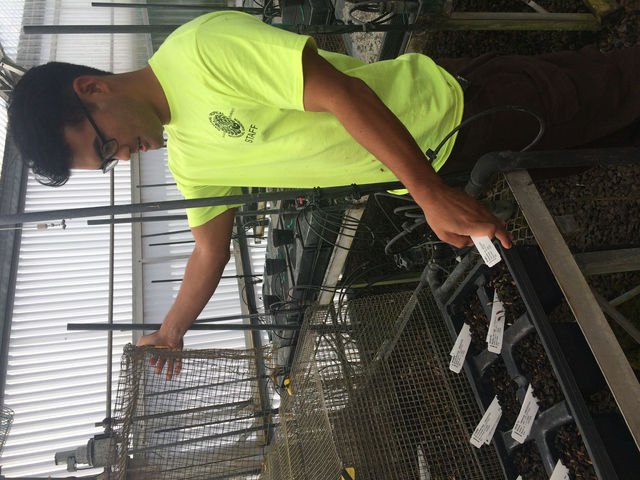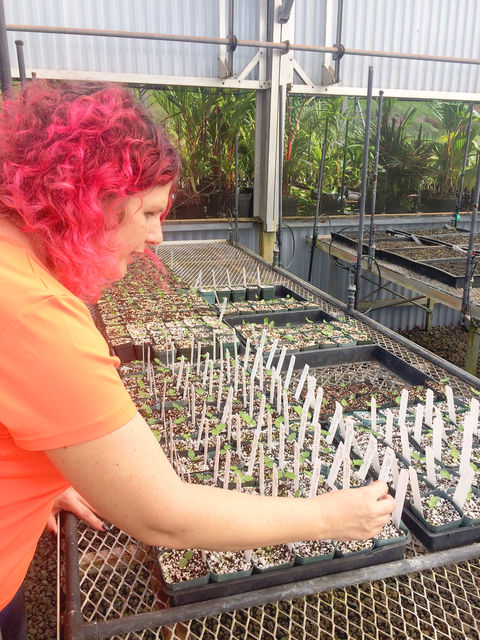There are only 40 Polyscias bisattenuata trees left in the wild and in two days, the staff at the National Tropical Botanical Garden multiplied that population by seven. “This is new territory,” said Ashley Trask, NTBG nursery manager. “It’s exciting to get
There are only 40 Polyscias bisattenuata trees left in the wild and in two days, the staff at the National Tropical Botanical Garden multiplied that population by seven.
“This is new territory,” said Ashley Trask, NTBG nursery manager. “It’s exciting to get this big of a collection and see what appears to be a good germination percentage.”
As of Wednesday, NTBG nursery manager Ashly Trask, along with volunteers and interns, had planted more than 44,000 Polyscias seeds and transplanted more than 300 seedlings.
And they’re not slowing down.
“We’ve still got collections coming in,” Trask said. “Probably at least another 10,000 seeds.”
Polyscias bisattenuata isn’t new to the NTBG nursery. Trask said they worked with a collection of roughly 10,000 seeds last year and there were only a handful that germinated.
“We figured out they’re being predated by rats, even in the nursery, so this year we caged all of our seeds,” Trask said. “In addition, we realized they don’t like to be dried out so instead we’re planting them immediately.”
But, nestled safely under their cages, the seedlings seem to be having better luck this time around.
“They’re all starting to sprout. They’re surviving and there’s thousands more that are already sprouting,” Trask said.
In the wild, rats and non-native birds heavily predate Polyscias bisattenuata fruits and there is no longer a natural pollinator, according to the International Union for Conservation of Nature Red List of Threatened Species.
IUCN lists the plant as critically endangered and points out it has experienced “ongoing decline in habitat and likely numbers due to the impacts of invasive plants and animals.”
It’s endemic to Kauai and the seeds are being collected by NTBG field botanist Natalia Tangalin and Randy Umetsu, from Eleele, an intern with NTBG.
“We have spent so much time hiking and going out there collecting these seeds,” said Umetsu, who is working to grow the trees in the NTBG nursery.
Umetsu has been with NTBG since October and has been involved in the project since then.
“Now I am cleaning and planting them (the seeds),” Umetsu said.
That project started with the placement of rat-resistant bags, made by NTBG volunteers, over the few remaining wild plants. Those bags protected more than 6,600 Polyscias fruits, which NTBG collected.
After collection, some of those seeds went to the nursery and some went to the NTBG seed bank under the care of manager Dustin Wolkis, who also manages the NTBG lab.
“In order to make a significant impact on the conservation and continuation of a species, we need to know how they’re going to behave when they’re stored and they need to be stored,” Wolkis said. “You can’t put all your eggs in one basket.”
Storing seeds is also a recommendation of the Hawaii Strategy for Plant Conservation, which outlines efforts to reduce threats to native plants species and aims to coordinate conservation programs statewide.
“The idea, too, behind seed banking is that you can hold (the seeds) until another time when the habitat is managed appropriately, and you can put them back out,” Wolkis said.
While everyone is excited about the potential outcomes NTBG’s work on the Polyscias bisattenuata plants, the project is also a good example of how the different areas of NTBG work together.
“This really is the result of work from every single part of NTBG and it’s really exciting,” said Tessa McSwain, spokeswoman for the organization. “Every hand was in the pot.”




